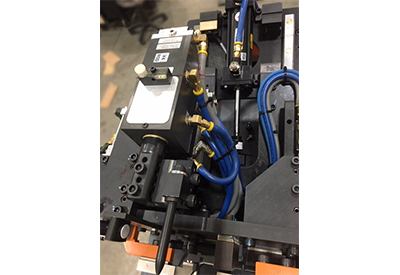New locating pin with locking capability enhances safety in auto manufacturing

June 18, 2019
Festo has introduced the first mechanical locking variant of a retractable locating pin, an important safety upgrade for a component used widely in North American automotive assembly plants and by their Tier 1 and Tier 2 suppliers.
Locating pins are large pneumatic positioning components used primarily for aligning heavy sheet metal parts for welding and fastening as part of assembling car bodies or sections thereof. Festo is the exclusive global distributor for Zaytran Automation’s locating pins and grippers.
In an automaker’s assembly plant body shop, where metal handling and joining are exclusively performed by robots, standard locating pins continue to suffice; there are limited cases for employing a safety variant. However, at many Tier 1 and Tier 2 suppliers, retractable locating pins are used in applications with human involvement. Between operations, a pin can retract unexpectedly, causing a load to shift. It’s a risk Zaytran’s safety variant eliminates.
The industry had been relying on a widely held assumption that it requires the exertion of at least 25 pounds of force for the shaft of a locating pin to retract, says Chris Hemming, Industry Segment Manager – Automotive at Festo Canada. “That may be true of a brand new pin, but over time, through wear and tear, that ceases to be the case, and quickly – to the point where one may retract with minimal force.”
Zaytran’s new LSA-95 series safety variant is the only locating pin with the protection of a mechanical spring locking mechanism. The lock engages automatically when the cylinder is in the fully extended position and the pilot air holding the lock is exhausted. Once the lock is engaged, the operator can work without the risk of inadvertent load movement. The mechanical lock can resist a force of up to 400 pounds. Furthermore, a mechanical lock is an active system, requiring specific actions by the operator to engage and disengage. That’s more reliable than current passive systems. The LSA-95 pilot air signal also can be integrated into any planned or existing safety circuitry, effectively creating a PL-d level safety condition. That’s a feature currently available only with this cylinder.
“Safety is always top-of-mind with Tier 1 and Tier 2 companies, but the risk posed from unexpected movement with locating pins only became a focus in the last 18-24 months,” says Hemming. “Last year, multiple customers told us they’d like to eliminate that hazard. Working with Zaytran, we’ve brought forward that solution with this locking variant.”
Even better, added Hemming, the new LSA-95 safety variant is dimensionally identical to Zaytran’s standard LSA-95 series, with all the same advantages that make the latter the overwhelming standard of the North American automakers. The LSA-95 is maintenance-free, and subject to design signoff, is guaranteed for the life of the tooling.
















